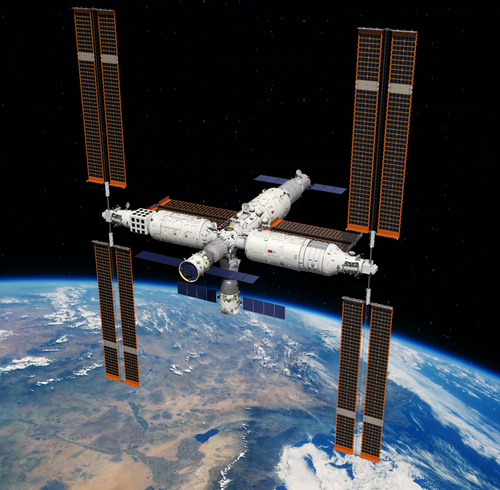
China's Tiangong Space Station is operational and is poised to rival the International Space Station (ISS) and comes at a time when the ISS is locked in a fierce political battle between Russia and the US due to the Ukraine war.
Bloomberg reports that spacecraft Shenzhou-14, atop a Long March-2F carrier rocket, was moved to a launchpad at the Jiuquan Satellite Launch Center in northwest China on Sunday. The Shenzhou-14 crewed spacecraft will ferry three astronauts to Tiangong in early June for a six-month mission.
China will have a busy year expanding the Tiangong. A total of six space flights will be carried out this year. In May, a cargo spacecraft delivered supplies to the station. Next will be the Shenzhou-14 human-crewed spacecraft. Then the launch of the Wentian lab module in June. The launch of the Tianhe core module in July and another lab module in October. Another three astronauts aboard the Shenzhou-15 human-crewed spacecraft will be taken up later this year to stay in orbit for six months.
Last week, China released a never-before-seen image of Tiangong, orbiting above the Earth at 250 miles.
Under President Xi Jinping, China has ambitious expansion plans for the Tiangong. In April, Beijing invited international and commercial partners to the new station as Russia quits the ISS.
The uncertainty gripping the ISS due to Washington's sanctions on Russia for invading Ukraine has pushed Russia and China closer.
Before the Ukraine conflict, Russian space agency Roscosmos signed a memorandum of understanding with China's National Space Administration, agreeing to work together on an international lunar research station.
The race for space dominance appears to be morphing into a multi-polar playing field—the US and European allies against Russia and China.
With ISS retiring by 2030, China's Tiangong will be the only space station operational unless the US has a replacement. The US has enjoyed complete space dominance for decades, though the gap appears to be closing.
China’s Tiangong Space Station is operational and is poised to rival the International Space Station (ISS) and comes at a time when the ISS is locked in a fierce political battle between Russia and the US due to the Ukraine war.
Bloomberg reports that spacecraft Shenzhou-14, atop a Long March-2F carrier rocket, was moved to a launchpad at the Jiuquan Satellite Launch Center in northwest China on Sunday. The Shenzhou-14 crewed spacecraft will ferry three astronauts to Tiangong in early June for a six-month mission.
China will have a busy year expanding the Tiangong. A total of six space flights will be carried out this year. In May, a cargo spacecraft delivered supplies to the station. Next will be the Shenzhou-14 human-crewed spacecraft. Then the launch of the Wentian lab module in June. The launch of the Tianhe core module in July and another lab module in October. Another three astronauts aboard the Shenzhou-15 human-crewed spacecraft will be taken up later this year to stay in orbit for six months.
Last week, China released a never-before-seen image of Tiangong, orbiting above the Earth at 250 miles.
Under President Xi Jinping, China has ambitious expansion plans for the Tiangong. In April, Beijing invited international and commercial partners to the new station as Russia quits the ISS.
The uncertainty gripping the ISS due to Washington’s sanctions on Russia for invading Ukraine has pushed Russia and China closer.
Before the Ukraine conflict, Russian space agency Roscosmos signed a memorandum of understanding with China’s National Space Administration, agreeing to work together on an international lunar research station.
The race for space dominance appears to be morphing into a multi-polar playing field—the US and European allies against Russia and China.
With ISS retiring by 2030, China’s Tiangong will be the only space station operational unless the US has a replacement. The US has enjoyed complete space dominance for decades, though the gap appears to be closing.





